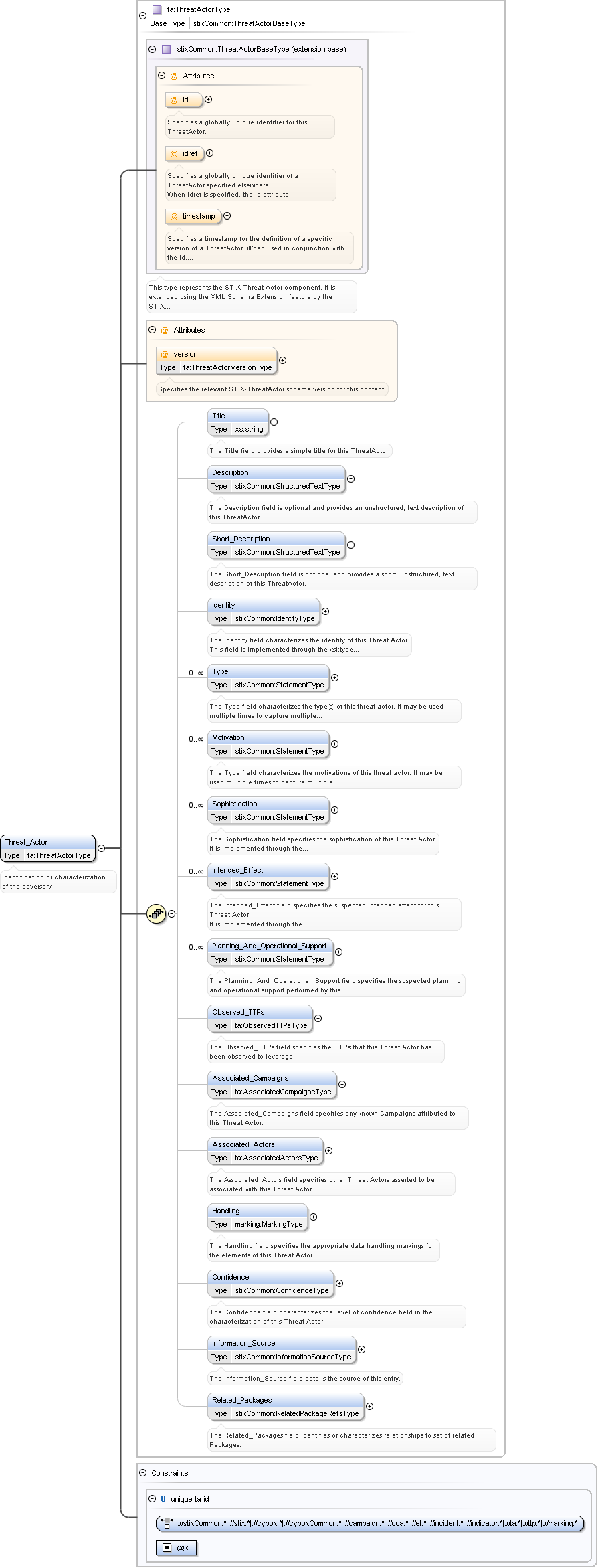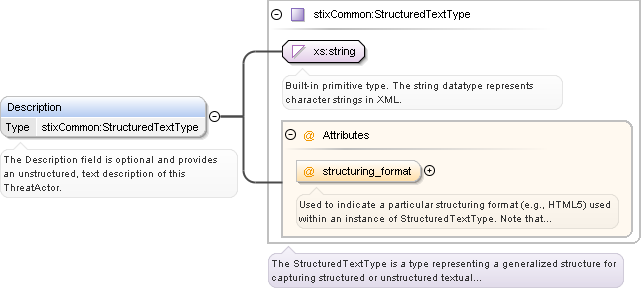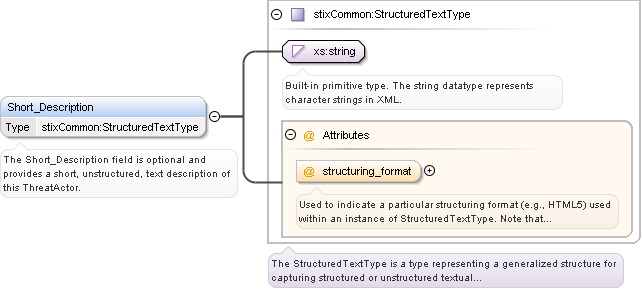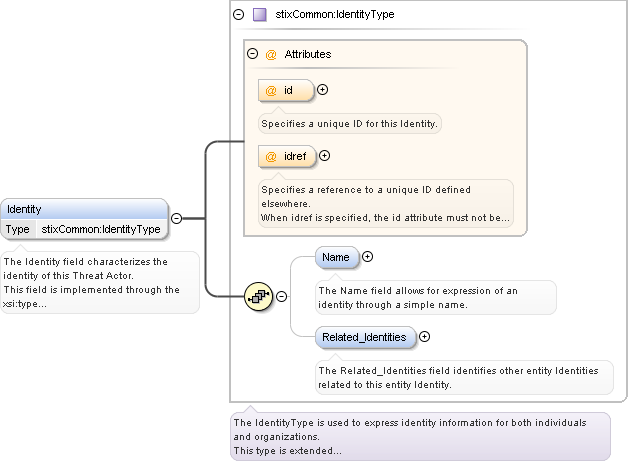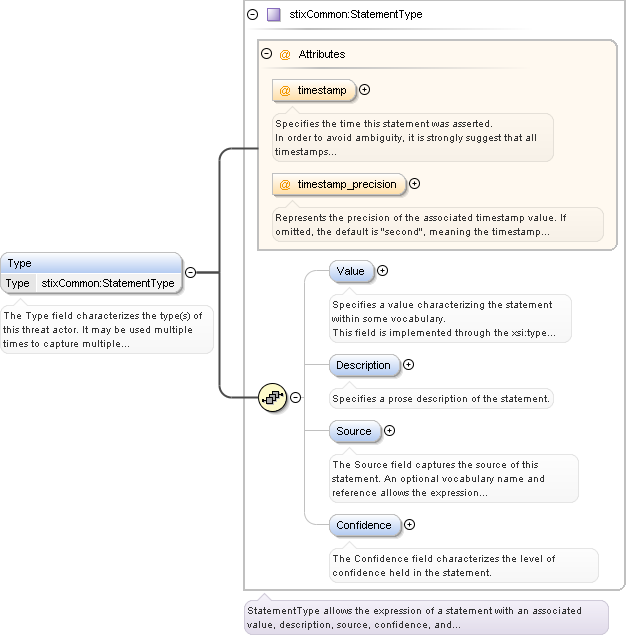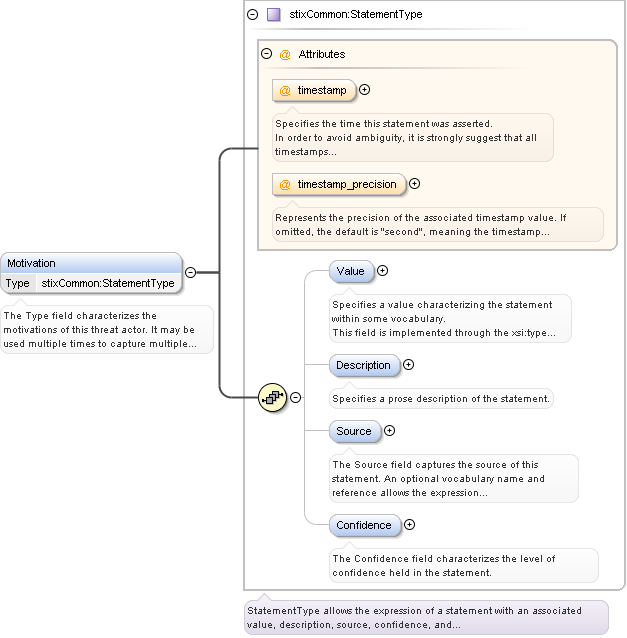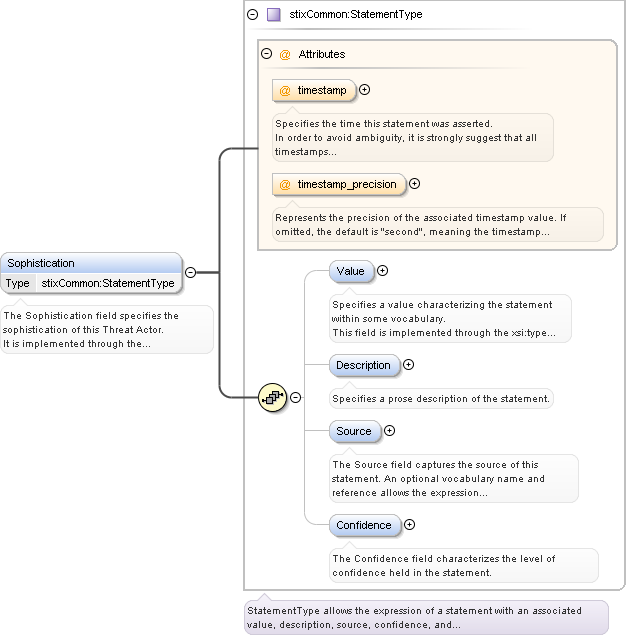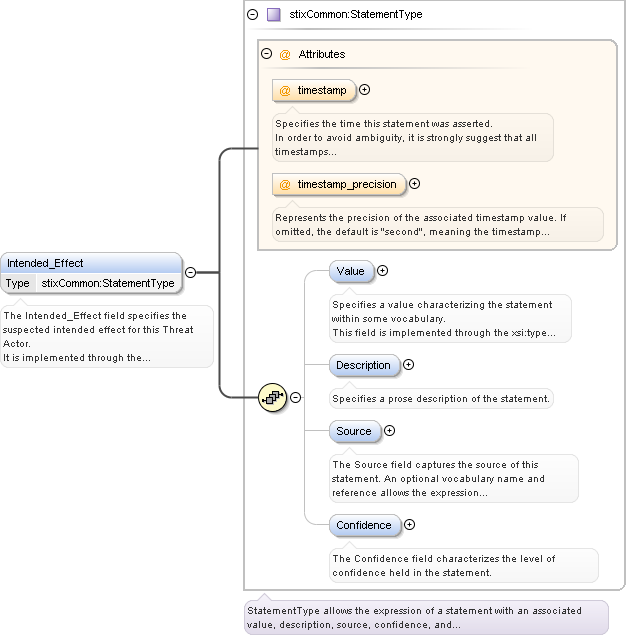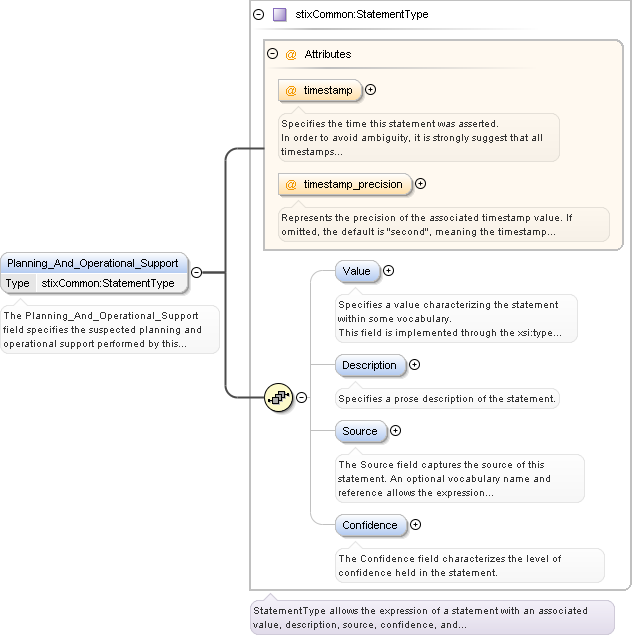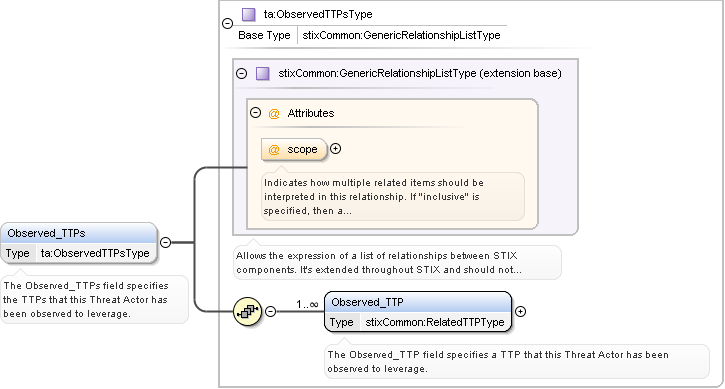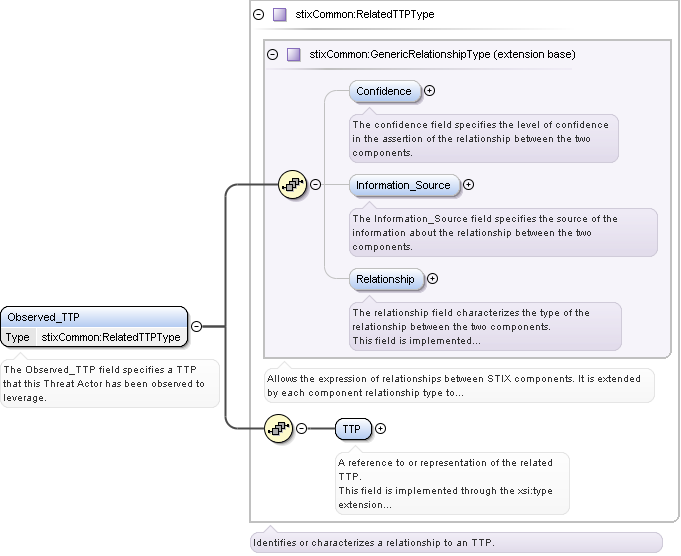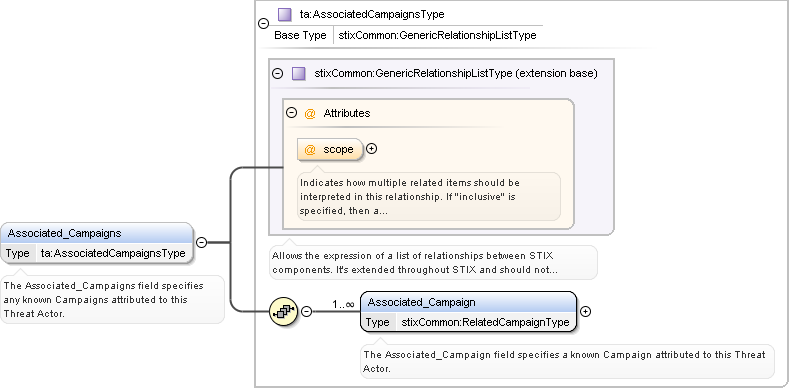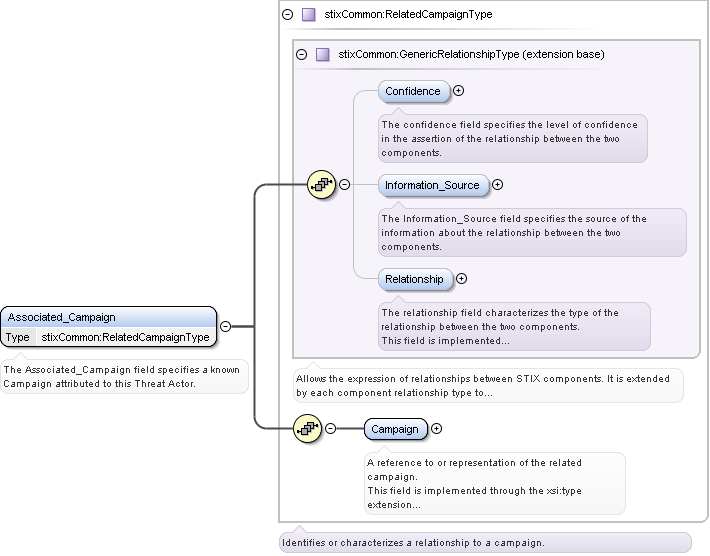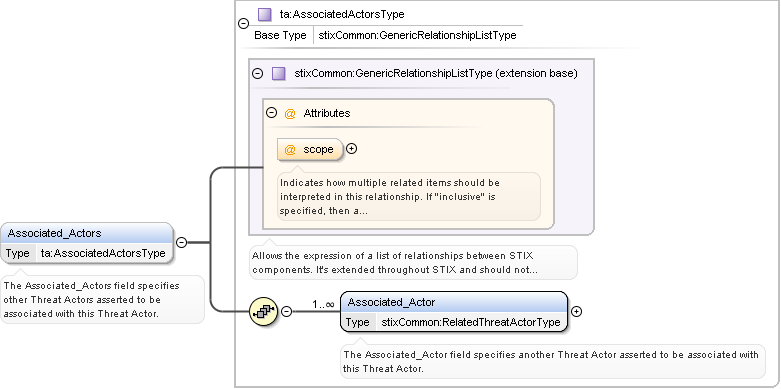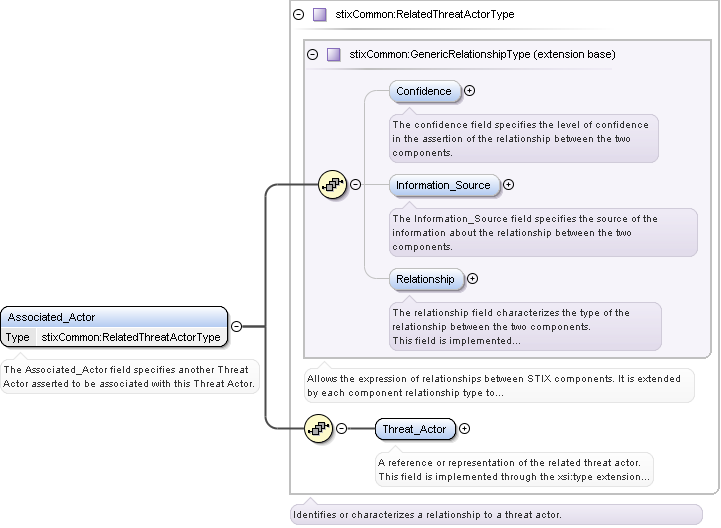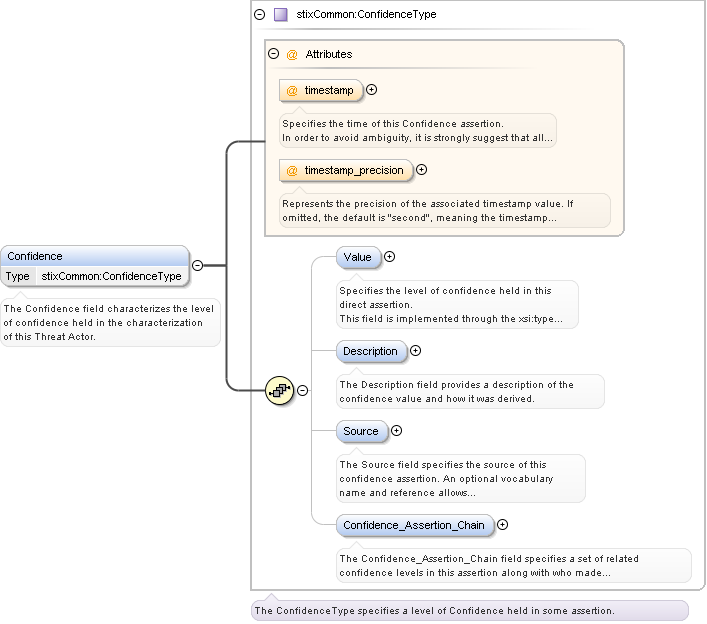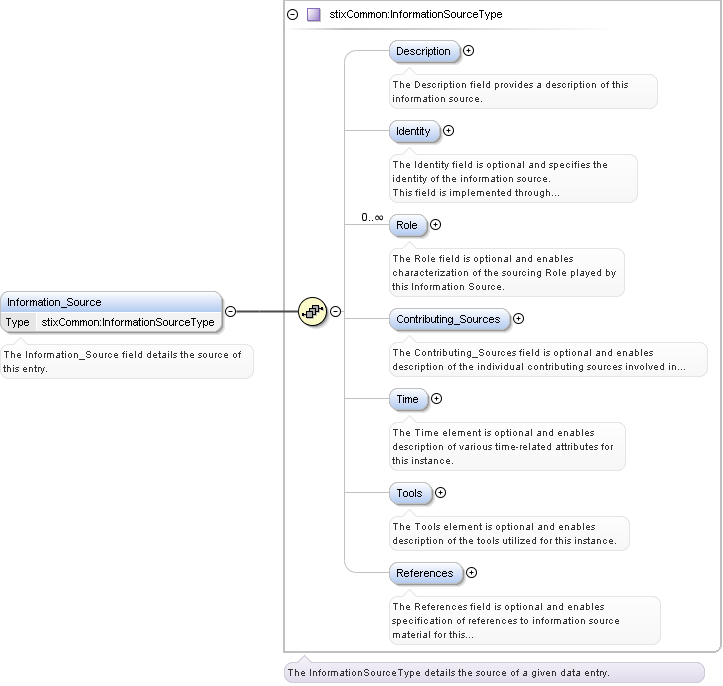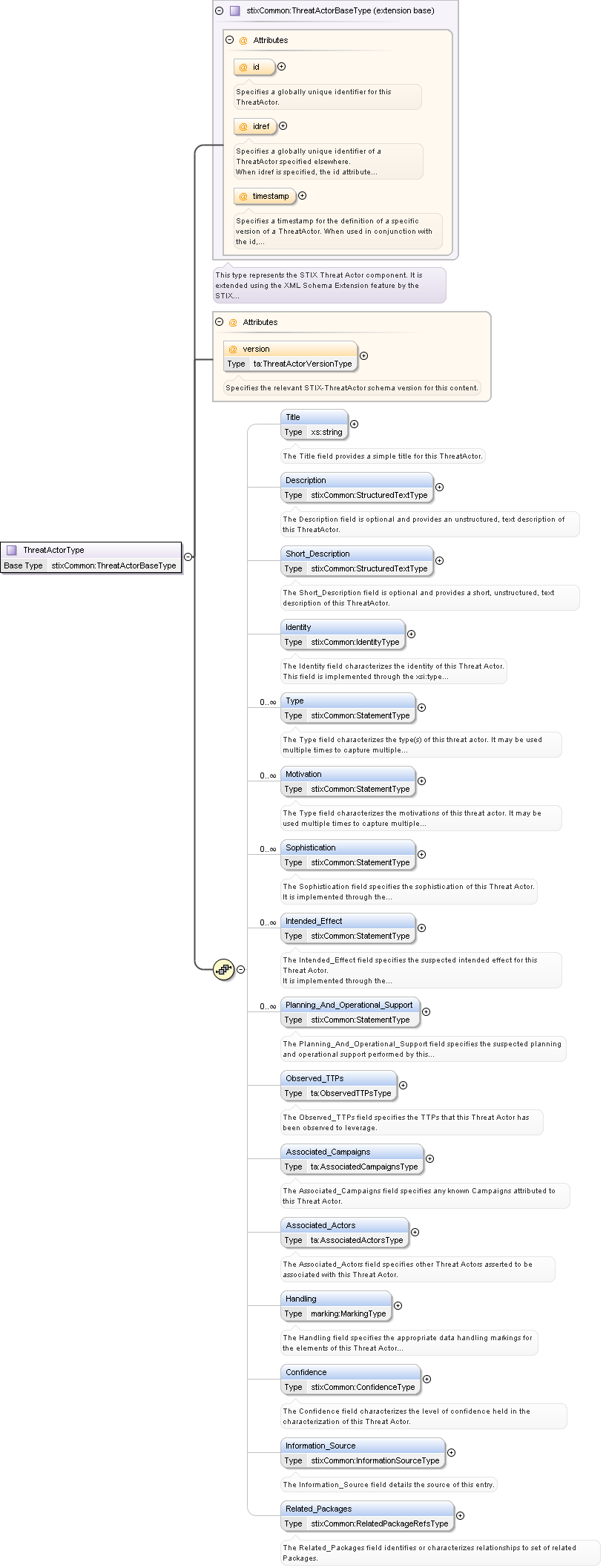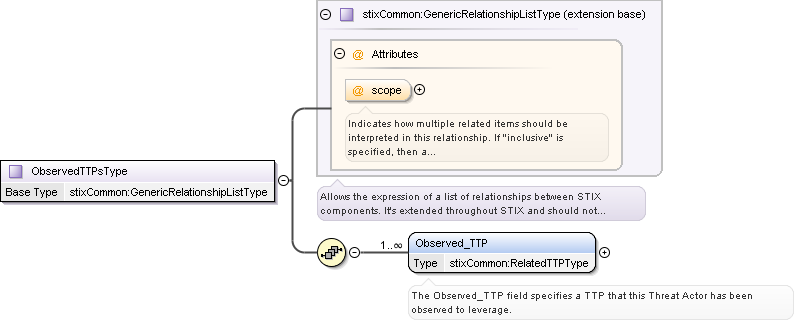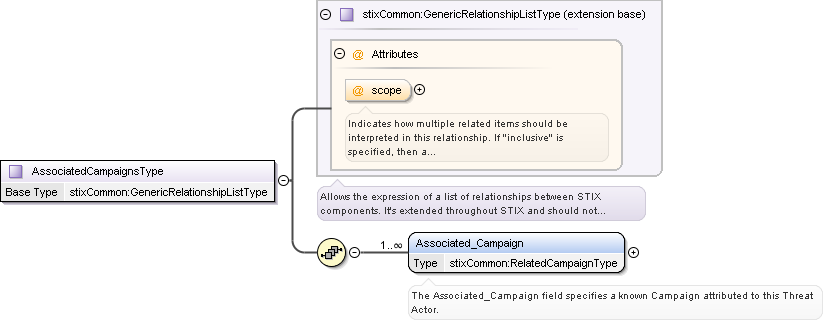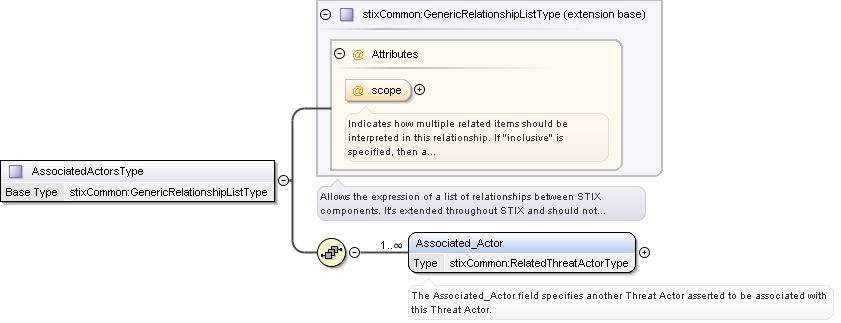<xs:complexType name="ThreatActorType">
<xs:complexContent>
<xs:extension base="stixCommon:ThreatActorBaseType">
<xs:sequence>
<xs:element name="Title" type="xs:string" minOccurs="0">
<xs:annotation>
<xs:documentation>The Title field provides a simple title for this ThreatActor.</xs:documentation>
</xs:annotation>
</xs:element>
<xs:element name="Description" type="stixCommon:StructuredTextType" minOccurs="0">
<xs:annotation>
<xs:documentation>The Description field is optional and provides an unstructured, text description of this ThreatActor.</xs:documentation>
</xs:annotation>
</xs:element>
<xs:element name="Short_Description" type="stixCommon:StructuredTextType" minOccurs="0">
<xs:annotation>
<xs:documentation>The Short_Description field is optional and provides a short, unstructured, text description of this ThreatActor.</xs:documentation>
</xs:annotation>
</xs:element>
<xs:element name="Identity" type="stixCommon:IdentityType" minOccurs="0">
<xs:annotation>
<xs:documentation>The Identity field characterizes the identity of this Threat Actor.</xs:documentation>
<xs:documentation>This field is implemented through the xsi:type extension mechanism. The default type is CIQIdentity3.0InstanceType in the http://stix.mitre.org/extensions/Identity#CIQIdentity3.0-1 namespace. This type is defined in the extensions/identity/ciq_identity.xsd file or at the URL http://stix.mitre.org/XMLSchema/extensions/identity/ciq_identity/1.1/ciq_identity.xsd.</xs:documentation>
<xs:documentation>Those who wish to express a simple name may also do so by not specifying an xsi:type and using the Name field.</xs:documentation>
</xs:annotation>
</xs:element>
<xs:element name="Type" type="stixCommon:StatementType" minOccurs="0" maxOccurs="unbounded">
<xs:annotation>
<xs:documentation>The Type field characterizes the type(s) of this threat actor. It may be used multiple times to capture multiple types.</xs:documentation>
<xs:documentation>It is implemented through the StatementType, which allows for the expression of a statement in a vocabulary (Value), a description of the statement (Description), a confidence in the statement (Confidence), and the source of the statement (Source). The default vocabulary type for the Value is ThreatActorTypeVocab-1.0 in the http://stix.mitre.org/default_vocabularies-1 namespace. This type is defined in the stix_default_vocabularies.xsd file or at the URL http://stix.mitre.org/XMLSchema/default_vocabularies/1.1.0/stix_default_vocabularies.xsd.</xs:documentation>
<xs:documentation>Users may also define their own vocabulary using the type extension mechanism, specify a vocabulary name and reference using the attributes, or simply use this as a string field.</xs:documentation>
</xs:annotation>
</xs:element>
<xs:element name="Motivation" type="stixCommon:StatementType" minOccurs="0" maxOccurs="unbounded">
<xs:annotation>
<xs:documentation>The Type field characterizes the motivations of this threat actor. It may be used multiple times to capture multiple motivations.</xs:documentation>
<xs:documentation>It is implemented through the StatementType, which allows for the expression of a statement in a vocabulary (Value), a description of the statement (Description), a confidence in the statement (Confidence), and the source of the statement (Source). The default vocabulary type for the Value is MotivationVocab-1.1 in the http://stix.mitre.org/default_vocabularies-1 namespace. This type is defined in the stix_default_vocabularies.xsd file or at the URL http://stix.mitre.org/XMLSchema/default_vocabularies/1.1.0/stix_default_vocabularies.xsd.</xs:documentation>
<xs:documentation>Users may also define their own vocabulary using the type extension mechanism, specify a vocabulary name and reference using the attributes, or simply use this as a string field.</xs:documentation>
</xs:annotation>
</xs:element>
<xs:element name="Sophistication" type="stixCommon:StatementType" minOccurs="0" maxOccurs="unbounded">
<xs:annotation>
<xs:documentation>The Sophistication field specifies the sophistication of this Threat Actor.</xs:documentation>
<xs:documentation>It is implemented through the StatementType, which allows for the expression of a statement in a vocabulary (Value), a description of the statement (Description), a confidence in the statement (Confidence), and the source of the statement (Source). The default vocabulary type for the Value is ThreatActorSophisticationVocab-1.0 in the http://stix.mitre.org/default_vocabularies-1 namespace. This type is defined in the stix_default_vocabularies.xsd file or at the URL http://stix.mitre.org/XMLSchema/default_vocabularies/1.1.0/stix_default_vocabularies.xsd .</xs:documentation>
<xs:documentation>Users may also define their own vocabulary using the type extension mechanism, specify a vocabulary name and reference using the attributes, or simply use this as a string field.</xs:documentation>
</xs:annotation>
</xs:element>
<xs:element name="Intended_Effect" type="stixCommon:StatementType" minOccurs="0" maxOccurs="unbounded">
<xs:annotation>
<xs:documentation>The Intended_Effect field specifies the suspected intended effect for this Threat Actor.</xs:documentation>
<xs:documentation>It is implemented through the StatementType, which allows for the expression of a statement in a vocabulary (Value), a description of the statement (Description), a confidence in the statement (Confidence), and the source of the statement (Source). The default vocabulary type for the Value is IntendedEffectVocab-1.0 in the http://stix.mitre.org/default_vocabularies-1 namespace. This type is defined in the stix_default_vocabularies.xsd file or at the URL http://stix.mitre.org/XMLSchema/default_vocabularies/1.1.0/stix_default_vocabularies.xsd.</xs:documentation>
<xs:documentation>Users may also define their own vocabulary using the type extension mechanism, specify a vocabulary name and reference using the attributes, or simply use this as a string field.</xs:documentation>
</xs:annotation>
</xs:element>
<xs:element name="Planning_And_Operational_Support" type="stixCommon:StatementType" minOccurs="0" maxOccurs="unbounded">
<xs:annotation>
<xs:documentation>The Planning_And_Operational_Support field specifies the suspected planning and operational support performed by this threat actor.</xs:documentation>
<xs:documentation>It is implemented through the StatementType, which allows for the expression of a statement in a vocabulary (Value), a description of the statement (Description), a confidence in the statement (Confidence), and the source of the statement (Source). The default vocabulary type for the Value is PlanningAndOperationalSupportVocab-1.0.1 in the http://stix.mitre.org/default_vocabularies-1 namespace. This type is defined in the stix_default_vocabularies.xsd file or at the URL http://stix.mitre.org/XMLSchema/default_vocabularies/1.1.0/stix_default_vocabularies.xsd.</xs:documentation>
<xs:documentation>Users may also define their own vocabulary using the type extension mechanism, specify a vocabulary name and reference using the attributes, or simply use this as a string field.</xs:documentation>
</xs:annotation>
</xs:element>
<xs:element name="Observed_TTPs" type="ta:ObservedTTPsType" minOccurs="0">
<xs:annotation>
<xs:documentation>The Observed_TTPs field specifies the TTPs that this Threat Actor has been observed to leverage.</xs:documentation>
</xs:annotation>
</xs:element>
<xs:element name="Associated_Campaigns" type="ta:AssociatedCampaignsType" minOccurs="0">
<xs:annotation>
<xs:documentation>The Associated_Campaigns field specifies any known Campaigns attributed to this Threat Actor.</xs:documentation>
</xs:annotation>
</xs:element>
<xs:element name="Associated_Actors" type="ta:AssociatedActorsType" minOccurs="0">
<xs:annotation>
<xs:documentation>The Associated_Actors field specifies other Threat Actors asserted to be associated with this Threat Actor.</xs:documentation>
</xs:annotation>
</xs:element>
<xs:element name="Handling" type="marking:MarkingType" minOccurs="0">
<xs:annotation>
<xs:documentation>The Handling field specifies the appropriate data handling markings for the elements of this Threat Actor characterization. The valid marking scope is the nearest ThreatActorBaseType ancestor of this Handling element and all its descendants.</xs:documentation>
</xs:annotation>
</xs:element>
<xs:element name="Confidence" type="stixCommon:ConfidenceType" minOccurs="0">
<xs:annotation>
<xs:documentation>The Confidence field characterizes the level of confidence held in the characterization of this Threat Actor.</xs:documentation>
</xs:annotation>
</xs:element>
<xs:element name="Information_Source" type="stixCommon:InformationSourceType" minOccurs="0">
<xs:annotation>
<xs:documentation>The Information_Source field details the source of this entry.</xs:documentation>
</xs:annotation>
</xs:element>
<xs:element name="Related_Packages" type="stixCommon:RelatedPackageRefsType" minOccurs="0">
<xs:annotation>
<xs:documentation>The Related_Packages field identifies or characterizes relationships to set of related Packages.</xs:documentation>
</xs:annotation>
</xs:element>
</xs:sequence>
<xs:attribute name="version" type="ta:ThreatActorVersionType">
<xs:annotation>
<xs:documentation>Specifies the relevant STIX-ThreatActor schema version for this content.</xs:documentation>
</xs:annotation>
</xs:attribute>
</xs:extension>
</xs:complexContent>
</xs:complexType> |
